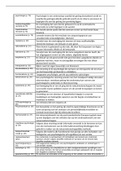Lecture notes
Oncology exam 2 full summary of lectures + practice exam and answers
- Module
- Institution
- Book
in this document, you will find a complete summary of all the lectures for the second oncology exam. including practice questions and answers.
[Show more]













